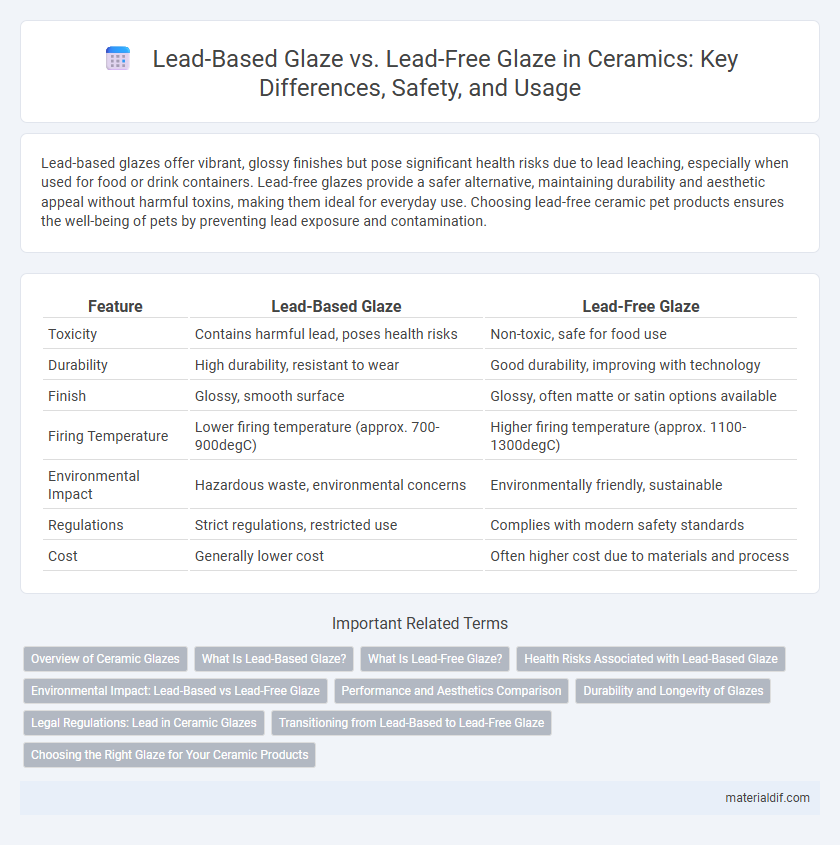Lead-based glazes offer vibrant, glossy finishes but pose significant health risks due to lead leaching, especially when used for food or drink containers. Lead-free glazes provide a safer alternative, maintaining durability and aesthetic appeal without harmful toxins, making them ideal for everyday use. Choosing lead-free ceramic pet products ensures the well-being of pets by preventing lead exposure and contamination.
Table of Comparison
| Feature | Lead-Based Glaze | Lead-Free Glaze |
|---|---|---|
| Toxicity | Contains harmful lead, poses health risks | Non-toxic, safe for food use |
| Durability | High durability, resistant to wear | Good durability, improving with technology |
| Finish | Glossy, smooth surface | Glossy, often matte or satin options available |
| Firing Temperature | Lower firing temperature (approx. 700-900degC) | Higher firing temperature (approx. 1100-1300degC) |
| Environmental Impact | Hazardous waste, environmental concerns | Environmentally friendly, sustainable |
| Regulations | Strict regulations, restricted use | Complies with modern safety standards |
| Cost | Generally lower cost | Often higher cost due to materials and process |
Overview of Ceramic Glazes
Lead-based glazes in ceramics provide a smooth, glossy finish with vibrant colors but pose significant health risks due to lead leaching, especially in food-related wares. Lead-free glazes use safer compounds like boron and zinc oxides to achieve similar aesthetic qualities without toxicity, making them the preferred choice for modern ceramic production. The selection between lead-based and lead-free glazes impacts durability, color range, and safety compliance in ceramic glazing.
What Is Lead-Based Glaze?
Lead-based glaze is a ceramic coating containing lead oxide, which lowers the melting temperature and produces a glossy, smooth finish. It enhances vibrant color retention and improves glaze adhesion but poses health risks due to lead leaching, especially in food-contact items. Regulatory agencies often restrict its use to prevent lead poisoning and ensure consumer safety.
What Is Lead-Free Glaze?
Lead-free glaze is a ceramic coating formulated without lead compounds, ensuring safer use in foodware and reducing health risks associated with lead exposure. It utilizes alternative materials such as boron, zinc, and alkaline earth metals to achieve a durable, glossy finish while meeting strict regulatory standards for toxicity and environmental safety. Lead-free glazes offer improved chemical stability and comply with international guidelines like those from the FDA and EU, making them ideal for modern ceramic production.
Health Risks Associated with Lead-Based Glaze
Lead-based glazes release toxic lead particles when improperly fired or damaged, posing significant health risks including lead poisoning, neurological damage, and developmental delays, especially in children. Chronic exposure to lead from ceramic glazes can accumulate in the body, causing serious issues such as kidney damage, cognitive impairments, and reproductive problems. Lead-free glazes eliminate these hazards by using safer alternatives, ensuring ceramic products are non-toxic and environmentally friendly.
Environmental Impact: Lead-Based vs Lead-Free Glaze
Lead-based glazes release toxic lead particles during firing and over time, contaminating soil and water sources and posing significant health risks to ecosystems and humans. Lead-free glazes utilize safer alternatives like boron or zinc, greatly reducing environmental pollution and making ceramic production more sustainable. Choosing lead-free glazes supports eco-friendly practices by minimizing hazardous waste and preventing long-term ecological damage.
Performance and Aesthetics Comparison
Lead-based glazes offer superior brightness and smoothness, enhancing the visual appeal of ceramics with vibrant, glossy finishes that are highly durable and chip-resistant. Lead-free glazes, while safer and more environmentally friendly, may sometimes result in matte or less intense colors and can be less durable under heavy use or rapid temperature changes. Advances in lead-free formulations have improved their performance, making them increasingly competitive in achieving both aesthetic quality and long-term functionality.
Durability and Longevity of Glazes
Lead-free glazes offer enhanced durability and longevity compared to traditional lead-based glazes, as they resist crazing, chipping, and chemical degradation more effectively. Lead-based glazes, while providing a glossy finish, tend to be more prone to deterioration and potential health hazards over time. Advances in ceramic chemistry have made lead-free glazes a safer, eco-friendly choice without compromising strength and wear resistance.
Legal Regulations: Lead in Ceramic Glazes
Lead-based glazes are strictly regulated due to the toxic effects of lead exposure, with many countries enforcing maximum allowable lead content to protect human health. Lead-free glazes comply with these regulations by using alternative compounds that eliminate lead risk while maintaining glaze durability and appearance. Compliance with legal standards such as the U.S. FDA limits and the European Union's REACH regulation ensures ceramic products are safe for consumer use and environmental sustainability.
Transitioning from Lead-Based to Lead-Free Glaze
Transitioning from lead-based glaze to lead-free glaze reduces health risks associated with lead exposure in ceramics, while maintaining vibrant colors and durability. Advances in ceramic technology have enabled lead-free glazes to achieve similar aesthetic qualities and chemical stability without toxic components. Regulatory standards and consumer demand continue to drive the adoption of safer, environmentally friendly lead-free glazing materials.
Choosing the Right Glaze for Your Ceramic Products
Selecting the right ceramic glaze involves evaluating the health and environmental impact of lead-based glaze versus lead-free glaze, with lead-free options offering safer, non-toxic finishes suitable for food-related products. Lead-based glazes provide vibrant, glossy aesthetics but pose significant risks of lead leaching, making them less ideal for functional ceramics. Prioritizing lead-free glazes ensures compliance with safety regulations while maintaining durability and a wide range of colors for decorative and utilitarian ceramic items.
Lead-Based Glaze vs Lead-Free Glaze Infographic

 materialdif.com
materialdif.com